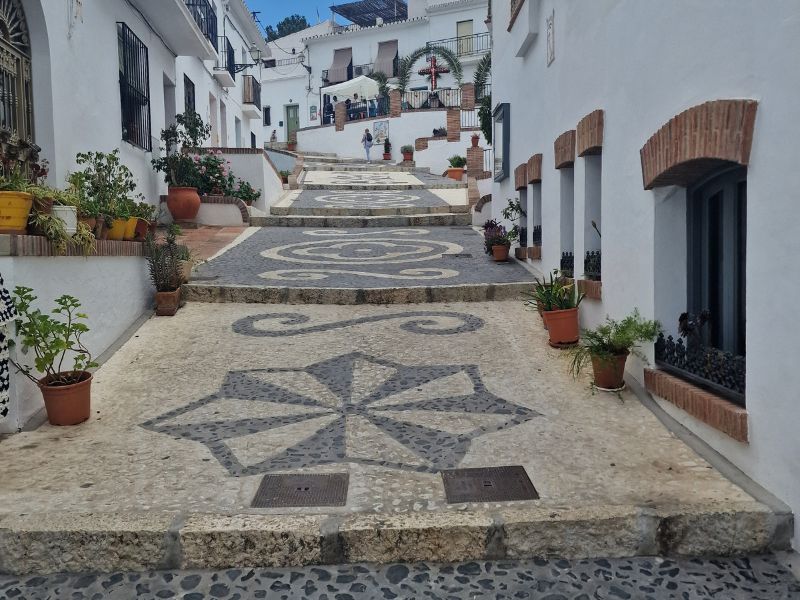To say Spain is a popular destination for digital nomads is an understatement. After all, who wouldn’t want to live work and play in Spain, a country offering plenty of sunshine, great food, a base for slow travel in Europe and being able to balance your work. One area in Spain in particular is a very attractive option for digital nomads – the Costa del Sol, Spain. So if you are looking for your next digital nomad destination guest posters Thomas and Paula of Tour Costa del Sol explain why the Costa del Sol should be at the top of your digital nomad destination list in Europe. And why it’s tops with them.
When I first imagined working remotely in southern Spain, the picture in my head was a little too perfect: laptop on the beach, iced coffee in hand, the Mediterranean sparkling in the background. Of course, reality is a little more nuanced. Sand in the keyboard isn’t as glamorous as it sounds. But living and working in the Costa del Sol has still been one of the most rewarding experiences of my life.
I’ve managed to keep my professional commitments on track while enjoying the region’s endless sunshine, rich culture, and a pace of life that encourages you to slow down and savour the moment. This is the story of how I’ve found balance here, along with a few tips if you’re thinking of doing the same.
Choosing the Costa del Sol as a Remote Base
The Costa del Sol stretches along Spain’s southern coast, from Nerja in the east to Manilva in the west. It’s a region that combines more than 300 days of sunshine a year with a Mediterranean lifestyle making even the busiest workdays feel less stressful.
For me, Málaga was the obvious choice as a base. It has a major international airport, reliable transport links, and a growing community of digital nomads and expats. But the magic of working here is that you’re never far from smaller towns and villages. Meaning you can wrap up a project in the morning and be exploring a quiet coastal path or hilltop pueblo by afternoon.
Crafting a Work Routine That Actually Works
I quickly learned that the key to balancing work and travel here is structure. Without it, the temptation to “just pop out for a coffee” can easily turn into an entire afternoon. I built my days around three key habits:
- Early starts. I wake with the sun, which rises gloriously over the Mediterranean most of the year. Getting in a few solid hours before the rest of the city fully wakes up means I can finish earlier.
- Block scheduling. I group my tasks so that focused work happens in two main chunks: early morning and late afternoon. This leaves the late morning and early afternoon open for errands, walks, or spontaneous adventures.
- Designated workspace. As romantic as working from a seaside café sounds, I get more done in a dedicated workspace. Keeping a desk at home for deep focus and save cafés for lighter admin or creative brainstorming.
This routine allows me to enjoy my surroundings without falling behind on client deadlines.
The Sunshine Factor
I underestimated just how much the Costa del Sol’s climate would impact my mood and productivity. Coming from a place with long, grey winters, the steady supply of light here feels almost medicinal.
Sunny days encourage me to take walking breaks instead of slumping at my desk. I’ve found that even a quick coffee on the balcony recharges my focus. The warmth also extends the possibilities for travel. In many European cities, winter means hibernating, but here, you can spend January hiking in a T-shirt or enjoying a seaside lunch.
Of course, the heat in midsummer can be intense, so I adjust my schedule then: earlier starts, longer siestas, and more work done in the cooler evenings.
Slow Travel Mindset
Living here has shown me that travel doesn’t have to mean constant motion. Slow travel — taking time to get to know one place deeply — fits perfectly with remote work. Instead of ticking off a list of “must-sees,” I’ve embraced the art of revisiting:
● Returning to the same market each week until I know the fishmonger’s name.
● Ordering coffee at the same café until the staff greet me like a regular.
● Taking morning walks along the same stretch of beach and noticing the subtle changes in light, tide, and activity.
This approach makes the Costa del Sol feel like home rather than just a backdrop for work. It also means that when I do explore somewhere new say, the whitewashed streets of Mijas Pueblo or the winding alleys of Nerja, I can do it without rushing back to a desk.

walks along Nerja Beach
Balancing Work Commitments with Exploration
One of the best parts of remote work here is how easily you can blend professional and leisure time.
Some weeks are heavier with client calls and deadlines; on those days, my “travel” might just be a sunset stroll on the Malagueta promenade. Other weeks, when my workload is lighter, I can take a day trip to places like Ronda, Marbella, or Frigiliana.
The trick is to plan exploration around your work rhythm, not the other way around. I use local holidays and long weekends as anchors for bigger adventures, and I keep my travel radius small when I have tight deadlines. It’s amazing how much you can see and do within an hour of Málaga without sacrificing productivity.
The Food Connection
It’s impossible to talk about life in the Costa del Sol without mentioning the Spanish food. Eating here has become one of my favorite slow travel rituals.
Long lunches are the norm, and they’ve taught me to step away from the laptop without guilt. I’ve learned to savor boquerones en vinagre with crusty bread. Linger over a plate of gambas al pil pil, and appreciate the unhurried ritual of tapas-hopping with friends or colleagues after work.
Food here isn’t just nourishment — it’s part of the social fabric. Sharing a table builds relationships, and those connections make living abroad and settling in to life abroad more meaningful.

food connection, Caf, de Chinitas, Malaga
Navigating Practicalities as a Remote Worker
While the Costa del Sol feels idyllic, a few practical steps made it easier to settle in and work effectively:
● Internet reliability. Most urban areas have fast, stable connections, but I always check speeds before booking an Airbnb or co-living space.
● Workspace variety. Málaga and larger towns have co-working hubs if I need a change of scenery or more structured environment.
● Time zone alignment. Spain’s schedule is slightly offset from much of Europe, which can be helpful for morning productivity if you work with clients further west.
● Transport flexibility. Buses and trains cover much of the coast, but for more remote spots, having access to a car expands your options dramatically.
Finding Community
Remote work can be isolating anywhere, but the Costa del Sol has a surprisingly strong network of digital nomads, freelancers, and long-term travelers.
I’ve joined informal co-working meetups, language exchanges, and hiking groups. These connections keep me socially engaged and provide opportunities to share both professional advice and travel tips.
I’ve also found value in making friends outside the expat circle. Whether it’s chatting with neighbors, joining a local club, or attending town festivals, those interactions deepen the sense of belonging.
Managing the “Always On Vacation” Temptation
Here’s a reality check: working in a sunny, tourist-friendly location means constant temptation to treat every day like a holiday. The line between work time and leisure time can blur quickly.
To manage this, I stick to a few boundaries:
● I keep clear working hours, even if they shift seasonally.
● I don’t mix heavy client work with travel days — one inevitably suffers.
● I treat midweek outings as a bonus, not an expectation.
This discipline ensures I can enjoy my surroundings without letting work slide.
The Benefits I Didn’t Expect
Living and working here has brought changes I didn’t anticipate:
● Better health. The combination of fresh Mediterranean food, daily walking, and ample sunshine has improved my energy and mood.
● More creativity. New surroundings, languages, and experiences feed creative thinking in ways my old routine never did.
● Stronger work-life integration. I no longer feel like I’m cramming travel into the edges of my life; instead, it’s woven into my everyday existence.
Would I Recommend Being a Digital Nomad in Spain?
Absolutely — but with the caveat that it requires balance. If you come expecting a permanent vacation, you might be frustrated when work inevitably demands your attention. But if you embrace the slower rhythms of Andalusian life while maintaining your professional standards, you’ll find it’s possible to have both.
Final Thoughts
Balancing work, sunshine, and slow travel in the Costa del Sol isn’t about chasing perfection. It’s about making small, deliberate choices that allow you to do good work and enjoy where you are.
For me, that’s meant starting early, protecting deep work time, and embracing the region’s easygoing pace. It’s meant learning that a “productive” day can include both meeting a deadline and taking a long lunch in the sun.
Life here has taught me that the real luxury isn’t just the weather or the scenery. It’s the freedom to shape my days in a way that honors both my career and my curiosity. And that’s something I wouldn’t trade for any corner office in the world. If feeling digital nomad burnout, the Costa del Sol, Spain is a great place to master the digital nomad lifestyle.
Spain is just one popular digital nomad destination, there are some 60 plus countries with a digital nomad visa. Where will you live work and play next?






0 Comments